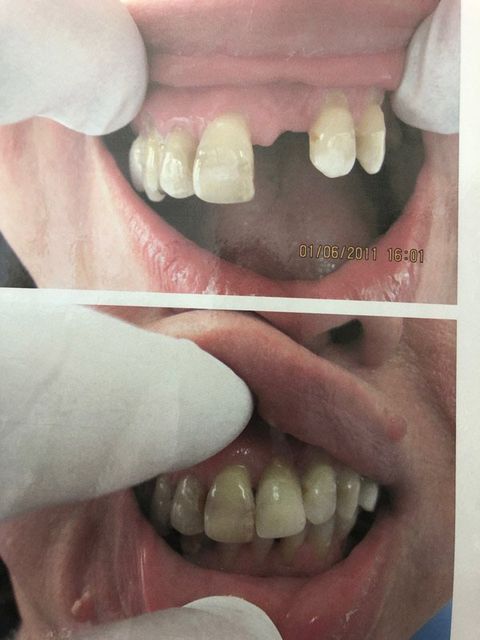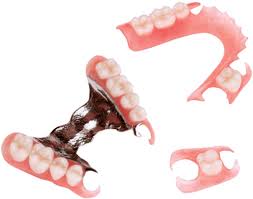Clinical Procedures
Clinical Procedures
And Possible Risks and Consequences
Usage:
A partial denture can be found either on the upper or lower jaw. A removable partial denture (RPD) can be made for patients in need from 1 to13 missing natural teeth. Partial dentures "fill in the gaps", they are false teeth you can remove to clean or during sleep. A partial denture enhances the persons appearance and aids in function such as improved eating and speaking. The use of a partial denture spreads the forces placed upon natural teeth during eating and chewing. It also stops natural teeth from "drifting" as the back teeth tend to drift forward and the upper back teeth drift downwards or upwards to find an opposing missing tooth.
Materials used:
Partial dentures at our denture clinics can be manufactured using chrome cobalt (a type of metal). Metal dentures are smaller thinner, stronger and last longer due to NO wear and tear. The clasps (clips) made from metal fit around the natural teeth perfectly and often tend to support them. This is due to a casting machine adapting the clasps directly onto your natural teeth during the process. Alternatively, plastic material can be used including "hi impact" acrylics. The chemical structure of such acrylics makes the denture material stronger, more resilient to wear and breakage, but it does not compare to the strength and size of a chrome cobalt denture material. The clasps of a plastic denture are hand wrought and cannot compete with the accuracy when using a centrifugal casting machine for a chrome cobalt denture. Then there are flexible thermoplastic dentures. These types of appliances are difficult to detect, they are durable and resistant to breakage. Our clinics more often provide this type of denture to any other.
Initial assessment:
The most important visit. Prior to commencement we will take a medical and dental history and obtain a reason for presenting. This includes answering a few questions concerning your general and dental health. The old dentures are also examined. This process allows us to obtain patients expectations, a treatment plan and a prognosis. We discuss all risks and consequences verbally and follow it up in written format. A written quotation of fees is given, alternatives and the method of payment discussed. If agreement is reached the next step for the denture treatment is arranged. (Time: approx. 30-40mins)
Primary impressions:
Initial impressions (imprint) of the upper and lower jaw are made. This involves placing special material (non-drip) into an appropriately sized impression tray and placing it into the mouth. Once to the upper jaw and once to the lower jaw. The reason for this procedure is to produce an initial model of the mouth in order to produce specially fitting trays, referred to as "special trays". These trays will be produced by our dental technician in the laboratory. (Time: approx. 30mins)
Secondary impressions:
Another lot of impressions is taken in the specially prepared "special trays" using different (usually non-drip) material. The reason for this procedure is to obtain a more accurate representation of the mouth. (Time: approx. 30mins)
Bite Registration:
A "bite block" (wax rim resembling a denture shape) is placed into the patients mouth and skilfully trimmed and manipulated to obtain the correct contour and length. Special measurements such as: centre, lip length and jaw relationship will be taken. This procedure will be checked on the next visit for its accuracy. At times the skill of the operator is not enough to get this procedure correct on the first time without the help of a relaxed and responsive patient. During this visit, teeth will be selected. This is discussed closely with the patient. The complexion, colour of hair, eyes and shape of the face as well as remaining natural teeth and the teeth on the old dentures are all taken into consideration. Once selected the next step will be prepared in the laboratory. At this point we would invite you to consider bringing someone during the next visit, someone who’s opinion you value as next visit as described below is very important. (Time: approx.30mins)

Try in:
The teeth selected during the previous visit are now presented to the patient set into the bite rim. This is like a denture made from wax with the teeth in place. You will be handed a mirror to see for yourself. Initially we will check all necessary dimensions as well as the previously taken bite registration. We will check the size and colour of the teeth, the number of teeth showing, check the centre of teeth and the formation and position of the lip. If all looks good and you agree we will then go ahead with your written authorisation to advance to the final finish state. Should you not be happy with the appearance we would reset the teeth to your instructions and reschedule for a retry instead. (Time: approx. 30mins)
New denture inserts:
The denture is now ready, and the wax has been replaced with highly polished and often characterised material that resembles human gingival tissue (gums). All dimensions and the retention are checked, and you will be shown the finished denture in a mirror. Instructions concerning the care of gums teeth and dentures are given verbally at length and patient expectations are discussed. Patient is instructed to persevere with the new denture but not over persevere and encouraged to return for a check visit in a week or earlier if necessary.

Check visit:
During this visit the patient tells us his/her problems (if any) with the new denture. The mouth and dentures are then thoroughly checked and if necessary, adjustment to the denture is made. Once again, the patient is reminded of returning for further adjustments at later stage if found necessary. Note: There are circumstance where this process described above may not be used. We may decide on a different technique more suitable or appropriate for a patient.
Wearing a Partial Denture
Risks and Consequences
In most cases removable partial dentures are a cost effective and successful replacement for “missing teeth” but as with all removable prosthetic treatment some risk exists depending on how well you look after your own teeth and gums and how you maintain your denture.
Most common risks and consequences include:
- Tooth Decay/Oral infection or inflammation: good oral hygiene is very important. Remove your denture when cleaning your natural teeth. Do not allow food remains to gather around clasps or hooks. If possible, rinse and clean after each meal and remove denture during sleep.
- Soreness: During the settling process the denture may rub or pressure your teeth or gums. Sore spots and/or ulcers may occur soon after the denture is fitted. Persevere but always return for adjustment(s) and fine tuning if symptoms persist.
- Speaking: may be altered for a short period of time until the tongue and your lips adjust to the new denture. Speech improvement usually occurs very quickly.
- Eating: chewing your food may be altered depending on variables such asstability, possible discomfort and the ability to provide the degree of retention–in time and with practice this will usually improve
- Taste and texture: Materials used for the construction of dentures may alter your taste of food, especially if the dentures are not cleaned properly. On the odd occasion rough or matt areas can be felt, return to your Dental Practitioner if of concern
- Staining/Plaque: The build-up of plaque and stain on dentures can be minimized by applying techniques as recommend by your Dental Practitioner. Apart from good oral hygiene avoiding such items as coffee, tea certain spices and tobacco to reduce staining. Inappropriate and/or irregular cleaning can cause for plaque and bacteria to build up. This bacterium can be ingested.
- Odour: Microscopic food debris can build up and therefore cause odour •Food under denture or around clasps: often unavoidable as food may get into the space between the denture and your gums or teeth during eating. The denture should be removed for cleaning possibly after each meal.
- Breakage or chipping: No parts are unbreakable. Just like your natural teeth can break, dentures can also become damaged. Biting into hard food, trauma to the mouth or dropping the denture are possible causes of causing breakage, chipping or loss of clasps.
- Reline/Remake: With recently extracted teeth the shape and size of your gums and bone will change overtime therefore a new fit of your denture may be needed. Dentures may well need to be relined or renewed depending on age and condition.












